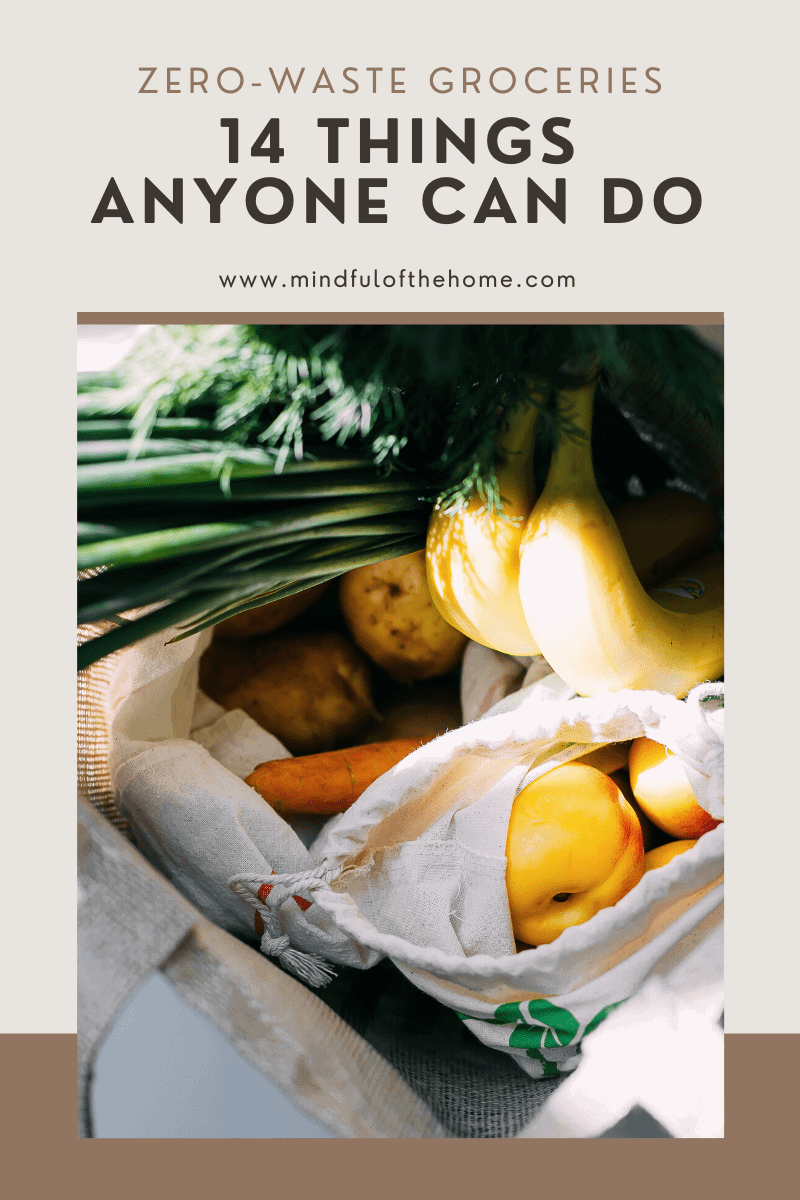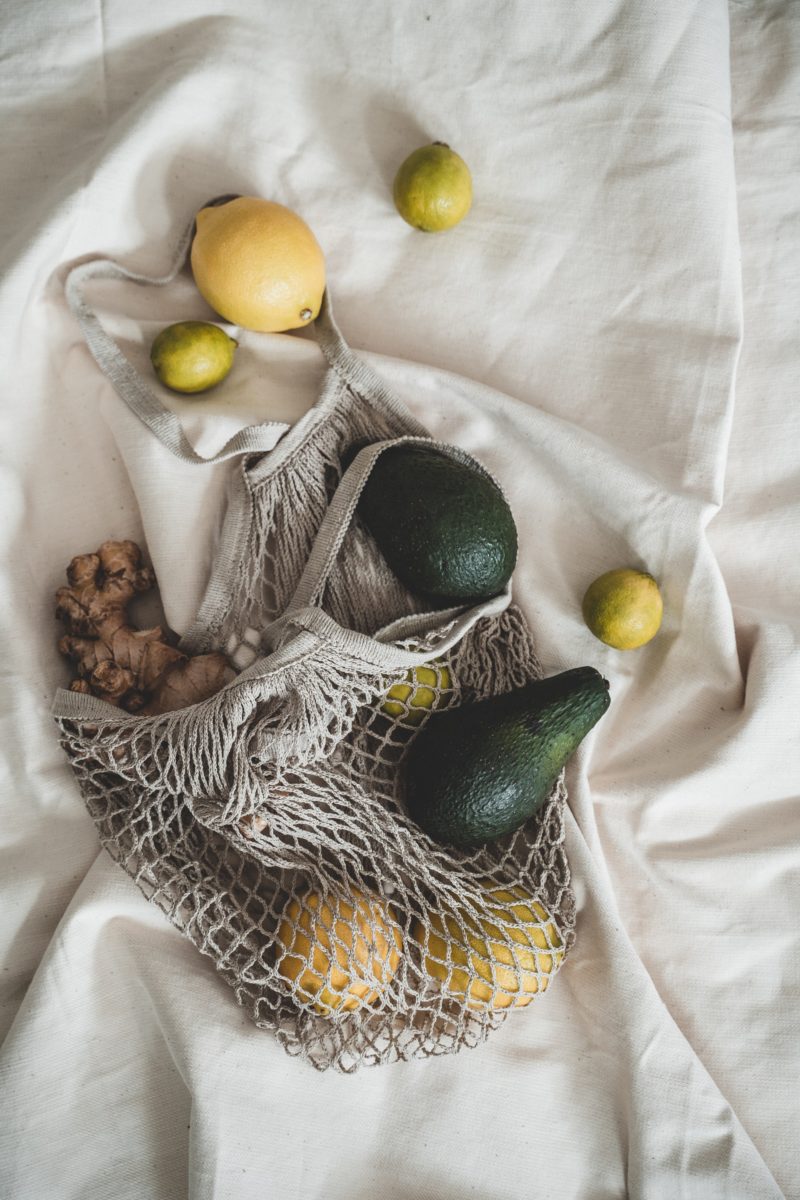There are quite a few things you can do to get zero-waste groceries, even if you don’t have access to a bulk store. I feel like the hardest part when trying to reduce waste is definitely when it comes to buying food, so these tips have really helped me get more low-waste groceries.
Since food is something that we need to buy over and over again, we need to make sure that we are buying our food without plastic and avoiding packaging that cannot be recycled or composted.
The good news?
There are some easy things that you can do to reduce your waste when grocery shopping without a bulk store so that you have as little plastic as possible.
Let’s get to it!

Here’s how to get low-waste groceries without a bulk store.
Aim for Low-Waste Packaging
The type of packaging your food comes in is the most important factor when it comes to getting low-waste groceries. But without a bulk store, it can be difficult to achieve.
Ideally, you want to aim for packaging made with wood/cardboard, metal, or glass because these three materials are easily recyclable.
If your groceries contain plastic, see if you can repurpose it. For example, there are some plastic items you can use for repurposed planters!
1. Buy Canned Food

Food in cans lasts a whole lot longer than perishables, helping reduce food waste. Cans are usually made with aluminum which is easily recyclable making it a guilt-free food option.
Just make sure you clean the can before adding it to your recycling bin.
Also, keep in mind that canned fruits and vegetables contain the same amount of nutrients, if not more, than fresh fruits and veggies.
2. Buy Frozen Fruit and Vegetables
If you tend to not eat fresh produce in time and it spoils, opting for buying frozen fruit and vegetables is a great way to counter that.
Keep the plastic bags and reuse them for freezing future fruits and vegetables! This is especially handy if you’re garden harvest is a big one and you need to freeze some veggies or fruit.
Just put fruits and veggies in the plastic bag according to their label, then it’s like a free labeled bag.
3. Buy Food That Comes in Glass Jars

A great way to get zero-waste groceries from your traditional grocery store is to buy food products that come in glass jars.
These jars can be repurposed around the house in a variety of ways such as for food storage and organizing items.
READ MORE: 22 Practical Ways to Repurpose Glass Jars at Home
4. Reuse Plastic Food Containers
A lot of food comes in plastic containers although not all plastic containers are the same.
The best low-waste option is sturdier plastic containers that can be reused for leftovers, repurposed, or recycled.
If you’re unsure, check the container to see if it indicates if it is recyclable or not but if you’re unsure about the different types of plastic and what the numbers mean, just feel the plastic and use your better judgment.
Plastic food containers are also great for starting seedlings in your garden. Just poke some holes through it to encourage drainage and you can reuse them year after year.
5. Buy Groceries in Bulk to Reduce Packaging Waste
When grocery shopping with no access to a bulk store, you can still technically buy in bulk. Buy the largest available size that the product comes in to help cut back on waste.
Although buying in bulk will cost you more upfront, you will still save money over the long run and reduce packaging waste.
TIP: ensure that when you buy in bulk, you eat it in time or store it correctly so that it won’t go to waste.
6. Don’t Buy Groceries With Individual Packaging

Food that comes individually packaged is extremely wasteful and something you want to start avoiding when trying to get low-waste groceries.
This can be tricky because a lot of snacks come with extra packaging, but definitely possible if you just keep an eye out when buying your groceries.
7. Buy Packaging-Free Produce

This may be a hard thing to do but try not to buy produce wrapped in plastic.
That type of plastic is the flimsiest of them all and is not recyclable so when it ends up in a landfill, it can easily get blown away and end up in waterways, and then to the oceans.
Make a point not to buy plastic-wrapped fruits and vegetables, even if it means that you need to skip something you often eat.
Shopping at farmers’ markets can be a great way to get around this. There’s usually no packaging and no stickers.
Create Your Own Zero-Waste Groceries
I feel like the only way to be 100% zero-waste in regards to food is to be self-sufficient and grow, raise, and make everything yourself.
That means growing fruits and vegetables, raising animals, and making your own things like cheese and butter.
Obviously, that’s not attainable for everyone due to where we live, our finances, or our personal beliefs, but there are some things that most people can accomplish to help make their own low-waste groceries.
8. Start Growing Your Own Produce

It may take some time and experience to become a great gardener, but it’s definitely attainable.
Growing vegetables and fruits in a garden is a realistic goal for almost anyone and one of the best ways to get zero-waste groceries.
That’s because you will have your own plastic-free grocery store in your backyard!
Don’t have a backyard? You can grow vegetables indoors too and you can have them all year round.
9. Plant Fruit Trees and Bushes

Same with growing produce in a garden, growing your own fruit bushes and trees is a great way to say goodbye to plastic packaging from grocery stores.
Trees and bushes are not as high-maintenance as a garden and can yield a lot of fruit. If you don’t have a backyard, here are some fruit trees you can grow indoors.
10. Cook Food From Scratch

Like potato chips but hate the unrecyclable bag? Make your own chips from sliced potatoes.
Hate buying bread in plastic bags? Start making your own!
There’s a lot of food you can substitute buying for making yourself. It might take some trial and error, and a little more time and effort in the beginning, but it will help you achieve low-waste groceries.
Zero-Waste Products to Bring to the Grocery Store
To avoid creating waste when grocery shopping, you need to ensure you’re coming prepared! Sometimes we create more unnecessary waste when we don’t bring our own!
11. Reusable Grocery Bags

Bringing your own grocery bags is one of the first things you should start doing when aiming for low-waste groceries.
Plastic bags that groceries offer are single-use plastic and you should avoid buying them at all costs.
Reusable grocery bags are one of the best zero-waste alternatives you can switch to, and they also make handling groceries a lot easier.
12. Reusable Produce Bags

Just like plastic grocery bags, the plastic produce bags available for putting fruits and vegetables in are also extremely wasteful.
Buy cotton mesh bags to hold your produce at the grocery store and use them for storing said produce at home too.
Cotton is biodegradable, so at the end of its long lifecycle, you can simply compost it. Boom, no waste.
TIP: keep your reusable bags in your car or by the door so you don’t forget them.
13. Cloth Bread Bag
If your grocery store offers fresh bread, bring your own cloth bag to store it in. Don’t have one? Use a pillowcase!
14. Bring Your Own Container
Most grocery stores have deli sections where you can get pre-cut meats and cheese or pre-made sides such as pasta and potato salads.
Oftentimes, they will allow you to bring your own container so that they can simply put the food in it instead of using their own packaging.
Final Thoughts on Shopping Low-Waste Groceries
When starting to cut back on the plastic waste you receive from grocery shopping, keep in mind that it’s better for you to make these changes gradually.
Don’t transition to all of these plastic-free packaging options at once. You might just get overwhelmed!
Instead, make these changes over time. For example, make a small change once a week and a big change once a month!
Want to make sure those groceries you’re purchasing aren’t going to waste? Check out my best tips for reducing food waste at home, perfect for people who struggle with eating food before it goes bad.


